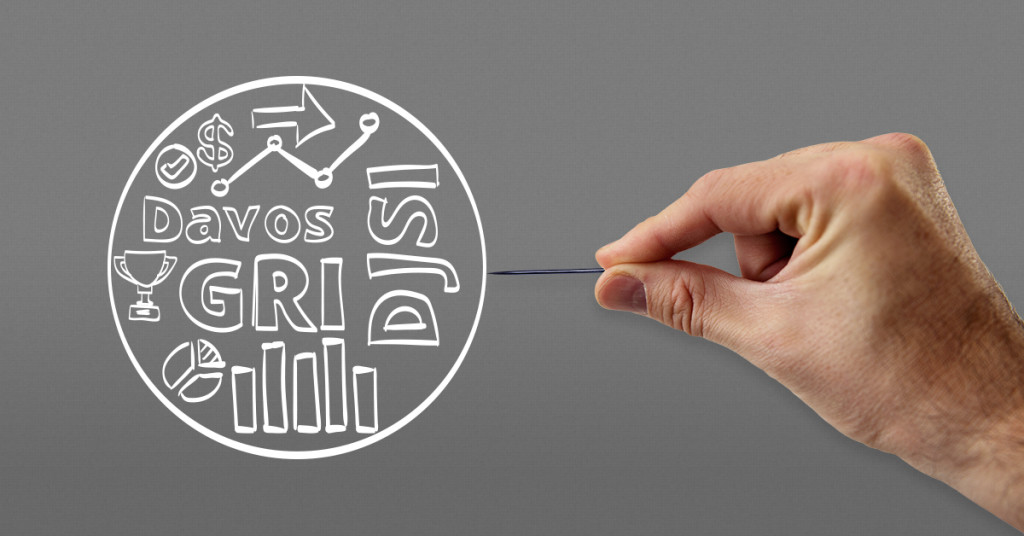This article originally appeared in The Fifth Estate.
You, you’re a sustainability person.
You need a strategy, right? Then a report. Then it’s time to enter the indices and awards – you know them – DJSI, GRI, Davos. The list goes on (and on).
Why? Well that’s how everyone does it, isn’t it?
Have you ever stopped to think, who looks at these wins? Who cares? Yes some people do, but are they the right people, or just the people in the ‘sustainability bubble’? Is there a better way?
The way we see it, sustainability can do lots of good things for your business. And most of them mean going beyond the bubble. So, whether you seek employee engagement, new shared value products to take to market or improved reputation and relations with your customers and investors, it’s worth beginning with why, and planning your strategy in way that makes sure the tools you employ are the right ones to lead you to the destination you seek.
So, let’s look at some of the whys – the outcomes you may want a sustainability or CSR strategy then look at the right tools to help you get there.
Employee Engagement
This is a big one. Not just for the current workforce, but for millennials entering too.
There’s oodles of research to show that millennials – and indeed Gen Y – will go out of their way to work for a company who shows a genuine commitment to CSR, environment and sustainability. And that current workers are more engaged and stay longer in a company that shows real purpose and commitment to reducing its impact on the world.
Like all people, employees respond to ideas and inspire and engage them. Telling them the sustainability team won an award just doesn’t cut the mustard.
Instead, why not explain the company’s commitment to clean energy by organising a bulk buy of solar panels for your employees’ homes? Or put on a giant clothes and children’s toys swap to explain your commitment to recycling? Getting people involved in an initiative gets attention and gives you a vehicle with which to then introduce people to your company’s commitments – and get them involved.
Make it engaging, give people a ‘what’s in it for me’, get the HR team involved, ask Corporate Communications to back you up with some PR, and don’t stop with just one initiative. Employee engagement will soon follow.
Reputation and community engagement
Again, talk is easy. Reputation is built on actions and involving people – not just telling them.
The best community engagement comes from getting out into the community. The best reputations are built on doing something important and, often, unexpected.
Why not borrow from the world of NGOs and pick a big issue then start a campaign to stop it. That’s how Patagonia becomes such a hero to their fans and customers.
Or, create a ‘test product’ that sends a message you’re innovating for change. There are plenty of examples out there, like Volvo’s reflective bicycle LifePaint. What better way to express their commitment to the safety of everyone on the roads – not just their drivers?
To do this, you’ll need to work with your brand and innovations teams.
You can also start the innovation process as an internal competition that asks employees to use sustainability as starting point for a new idea? That brings employee engagement in too.
The process creates something real and tangible. Actions not talk. And a clear pathway to improved reputation and community engagement
Investor relations
Ah, now we’re talking DJSI, Davos, GRI and the like.
Investors are risk averse beasts. They want to know you have identified your material issues and put a strategy in place to mitigate risks and identify opportunities. They understand indices; they’re prepared to take the time to read reports.
Still, a little creativity doesn’t go astray. Yes, your report needs to be GRI compliant, but it can do it in an engaging way. Simple story snapshots are one way to do this. Sustainability videos are another. It’s been shown that 75% of executives watch work-related videos (source: Forbes) and there’s a well-quoted factoid going around the web that videos are 1200% more likely to be shared than text documents and links.
So, win the awards, soar high on the indices, then tell investors in an engaging way.
But wait, there’s more
Employee engagement, reputation and investor relations are just three key reasons an organisation might get involved in sustainability. Cost savings government relations, innovation and new customer segments are others. And the list goes on.
Whatever the reason, the point still stands: you need to understand your ‘why’ – where you want to go – before you begin. Identifying what you seek to gain from your strategy will help you design it with outcomes in mind – and bring the right departments and people with you on journey, without spending time trying to engage the ones you don’t need.
It will help you put limited budget and people power into doing less but with a more defined outcome, instead of just choosing the same tools every other sustainability department seems to use.
It will help you bust sustainability out of the sustainability bubble.
And that can only be good for you, your team, your company and the world.
By Ben Peacock, Founder of Republic of Everyone.
Here at Republic of Everyone we work with sustainability leaders and give them the tools to make doing good, good for business.
Do you need help with your Shared Value/CR/Sustainability strategy, engagement, reporting or initiatives? Call us +61 2 8097 8746, email ben@republicofeveryone or drop us a line below.

